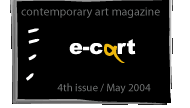




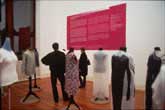
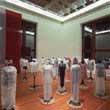
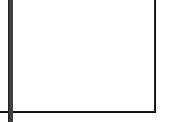







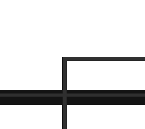

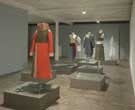



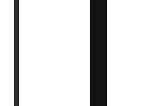
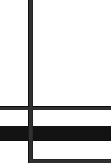






1. Question: If I am not wrong it is the first time when fashion is a significant part of an International Art Biennial. How did this happen? Does it have any importance that the main curator is a woman or the real reason is the way in which bb3 was conceived: like a show putting together different aspects of the past and contemporary Berlin urban life?
Answer: Fashion always played a role in fine arts - even though fashion seemed to not have always been appreciated in the arts, or has been mistaken as just "fashionable". But there are certainly interesting exhibitions and single works dealing with the subject of fashion. And right now it seems that fashion starts to play a more visible role in the art world again. The 3rd berlin biennial introduced five main subjects in the framework of so-called "hubs". Instead of an exhibition dealing with one main subject, there were five topics leading through the exhibition parcours like a red thread: "Other cinema", "Migration", "Sonic Scapes", "Urban Conditions" and "Fashion and Scenes". The research base of the invited cultural producers was to be Berlin. In my opinion, this approach was about not only to show a relationship between art, the city and the chosen subjects - as for example, fashion - but as well to involve various aspects of cultural practices - of artists, curators, writers, filmmakers, etc. who are creative in a number of professional roles. The subject is to work with and on a relationship of creators and producers from different fields, for example - an interconnection of working methodologies that are rendered inside of the art context.
2. Question: The idea that the past and the present have to be "sewed" for transition is not new. However, your approaching of this issue is very new. You emphasized some very interesting hypostasis of this continuum in terms of fashion history, with it's particularities in East and West Berlin. How can you explain this? Do you think that your work succeeds in offering a broadened understanding of this critical reality?
Answer: "Fashion and Scenes" involves a wide range of subjects - you can begin anywhere and end up nowhere. To avoid that, I decided to look closer into a time-period when the Berlin wall came down in 1989. I titled the work: Seam/Transition (in German: Nahtstellen/Umbruch). Both terms are related to the craft of tailoring, as well as they can be understood metaphorically: "seam" as a "seamline" bringing different textures together, and "transition", of which the German term "Umbruch" has a clear relation to the terminology of the "Wende", which commonly describes the process of political change in the fall of the Berlin Wall in 1989. I was interested to investigate worker's clothes and fashions in the GDR - the working society (Arbeiterstaat) in difference or relation to West German's attitudes towards fashion - for example when youth started to wear worn-out working clothes. But my approach has not been to typecast East or West. I was trying to lay out a scenography including various aspects of fashion in the GDR and BRD along relationships fashion anyway entails. The seam as a line has been metaphorically sewn together by the public: The public walking between the tailor dummies to read the stories imprinted on the cloth, fabrics or garment bags the tailor dummies wore. The tailor dummies have been installed along an imaginary stitch - a stitch used for transition in tailoring. And each tailor dummy with its information relates to the tailor dummies next to it - so you've got your story line walking between the dummies and reading from different perspectives. A public from the former GDR for example might re-act or read the stories according to her/his history different to a BRD public. It is not up to me what is the correct reading or understanding. It is more about showing "cuts" in a woven fabric - and how it is re-sewn it adds a new layer of story. And the layers of stories is the public itself - the social fabric.
3. Question: Your show was also accompanied by some performances. I assume you created in this way a dynamic balance for the static part of the show, the dressed dummies from KW Institute of Contemporary Art. Could you tell us more about the concept of your work?
Answer: This is not put correctly. The hub "Fashion and Scenes: Seam/Transition" has been my contribution as cultural producer. "embodiment" which has been shown at the Kunstwerke is one of my works I create as an artist. I have been invited to contribute in two ways: as cultural producer as well as an artist. embodiment is a label of mine under which i create prototypes of clothings. The term 'clothing' includes besides dress also furniture, wallpaper and other interior objects. The prototypes always relate to my own body measurements. The works of embodiment can be worn or used as functional design. They may be read as portraiture or sculpture. embodiment is to be understood as a link between art and design, body and costume design. At the 3rd berlin biennial I showed a selection of collections of clothes created between 1992 and 2004. And one particular piece of clothing - the "change coat" - has been newly produced in the context of the 3rd berlin biennial. The "change coat" related to one aspect of the hub: changes, transition. This coat has been specifically created to be worn in three different ways, and the use of specific textiles and tailoring embody protection, wall and changes. My works with embodiment for example are always produced within a thematic and context. Important is the textile used as texture: it is image/text - sound/language to layer symbolic reading levels. The embodiment dresses are each of them a story of an act on the stage of everyday life.
4. Question: I suppose the "hub" curated by you was conceived in a thematic and spatial relation with the other "hubs". In which way your work contributes to define the identity of Berlin social and cultural life, as the bb3 and its main curator Ute Meta Bauer aimed to outline it?
Answer: No - actually we did not interconnect spatially or thematically with the hubs in terms of conceptualizing our ideas together. We worked all pretty independently from each other but of course knowing what each of us is focusing on. It has been the curatorial program to interconnect and expand the relation to the invited artists. I don't have any ready-made definition at hand about Berlin's identity and what it is heading for or will become. Berlin is a lot about change and confusion, which of course is related to economy as well. It is not about "defining" social and cultural life - the work was about charting out some aspects of that, as well as contributing to it.
embodiment
Regina Möller designs prototypes for clothes under her label embodiment. She has expanded the term 'clothing' to include furniture, wallpaper and other interior objects. The prototypes always relate to the artist's own body measurements. They serve as models for limited editions, from which individual pieces are tailored for collectors/purchasers. The works from embodiment can be worn or used as functional design. They may be read as portraiture or sculpture. embodiment is to be understood as a link between art and design, body and costume design. (Regina Moller)
|
|
|
||||||||||||||||||||||||||||
|
|
 |
 |
|
||||||||||||||||||||||||||
 |
|
 |
|
||||||||||||||||||||||||||
|
|
|
||||||||||||||||||||||||||||
 |
|
||||||||||||||||||||||||||||
|
|
 |
|
 |
 |
|
||||||||||||||||||||||||
 |
 |
 |
|
||||||||||||||||||||||||||
| |
|
 |
 |
|
|||||||||||||||||||||||||
 |
 |
|
|||||||||||||||||||||||||||
 |
|
||||||||||||||||||||||||||||
|
|
|
|
|
||||||||||||||||||||||||||
|
|
|
||||||||||||||||||||||||||||
|
|
|
|
|||||||||||||||||||||||||||
 |
|
||||||||||||||||||||||||||||
|
|
 |
|
 |
|
 |
|
|
||||||||||||||||||||||
 |
|
||||||||||||||||||||||||||||
 |
 |
|
|||||||||||||||||||||||||||
|
|
|
|
|||||||||||||||||||||||||||
|
|
|
||||||||||||||||||||||||||||
 |
|
 |
|
 |
|
 |
 |
|
|||||||||||||||||||||
 |
|
||||||||||||||||||||||||||||
|
|
|
|
|
|
|||||||||||||||||||||||||
|
|
|
|
|
|
|
|
|
|
|
|
|
|
|
|
|
|
|
|
|
|
|
|
|
|
|
|
|
|
|